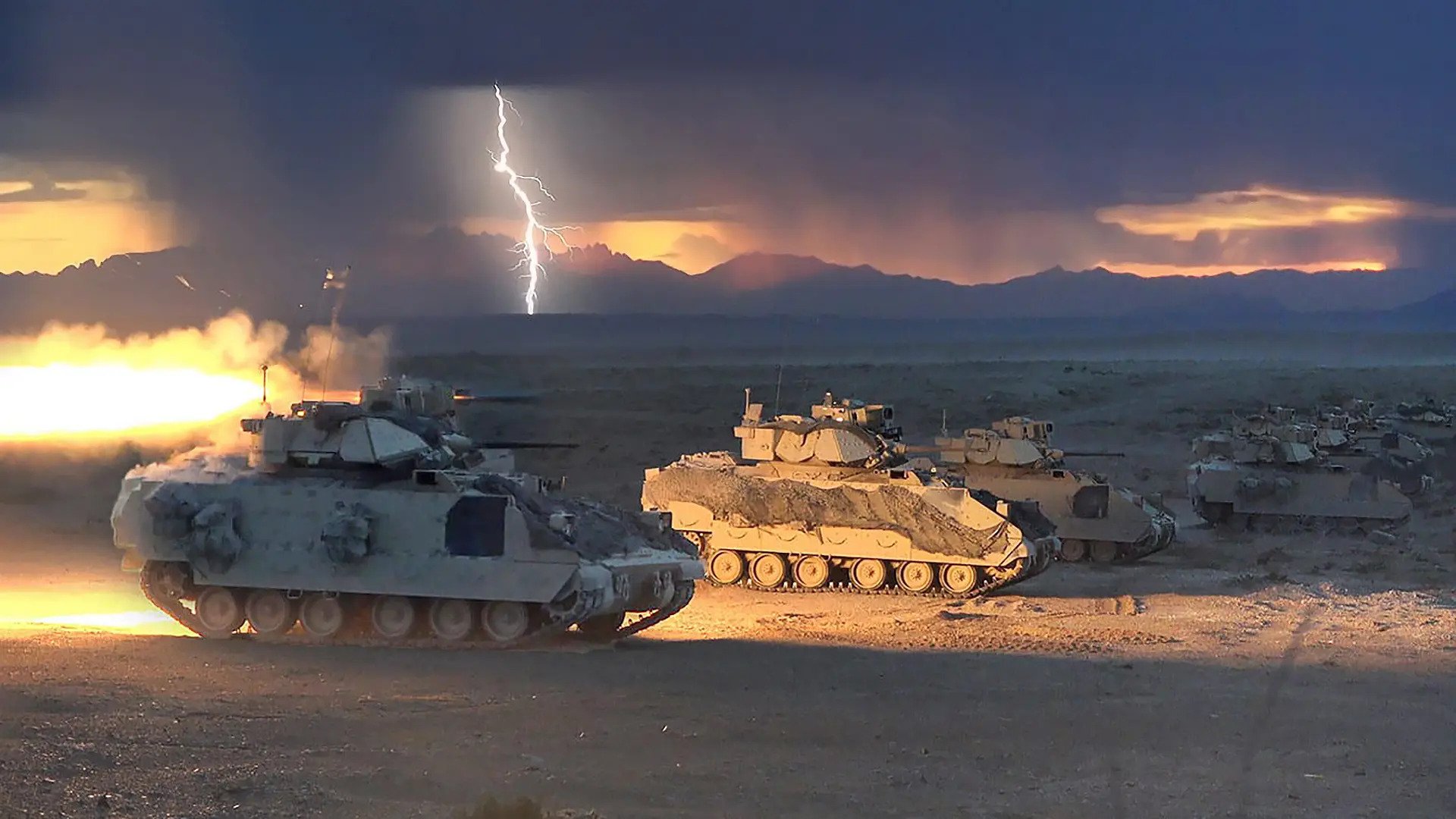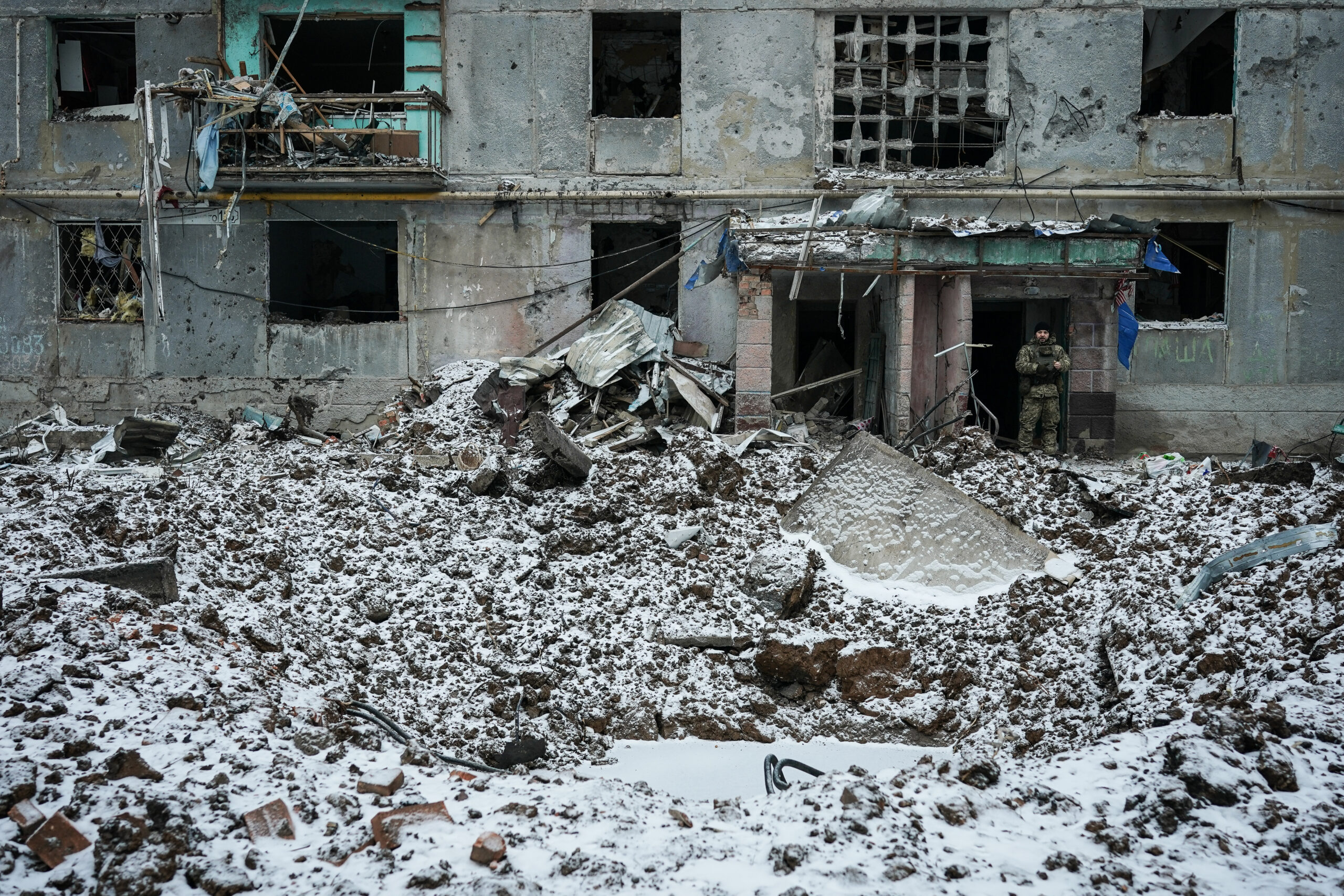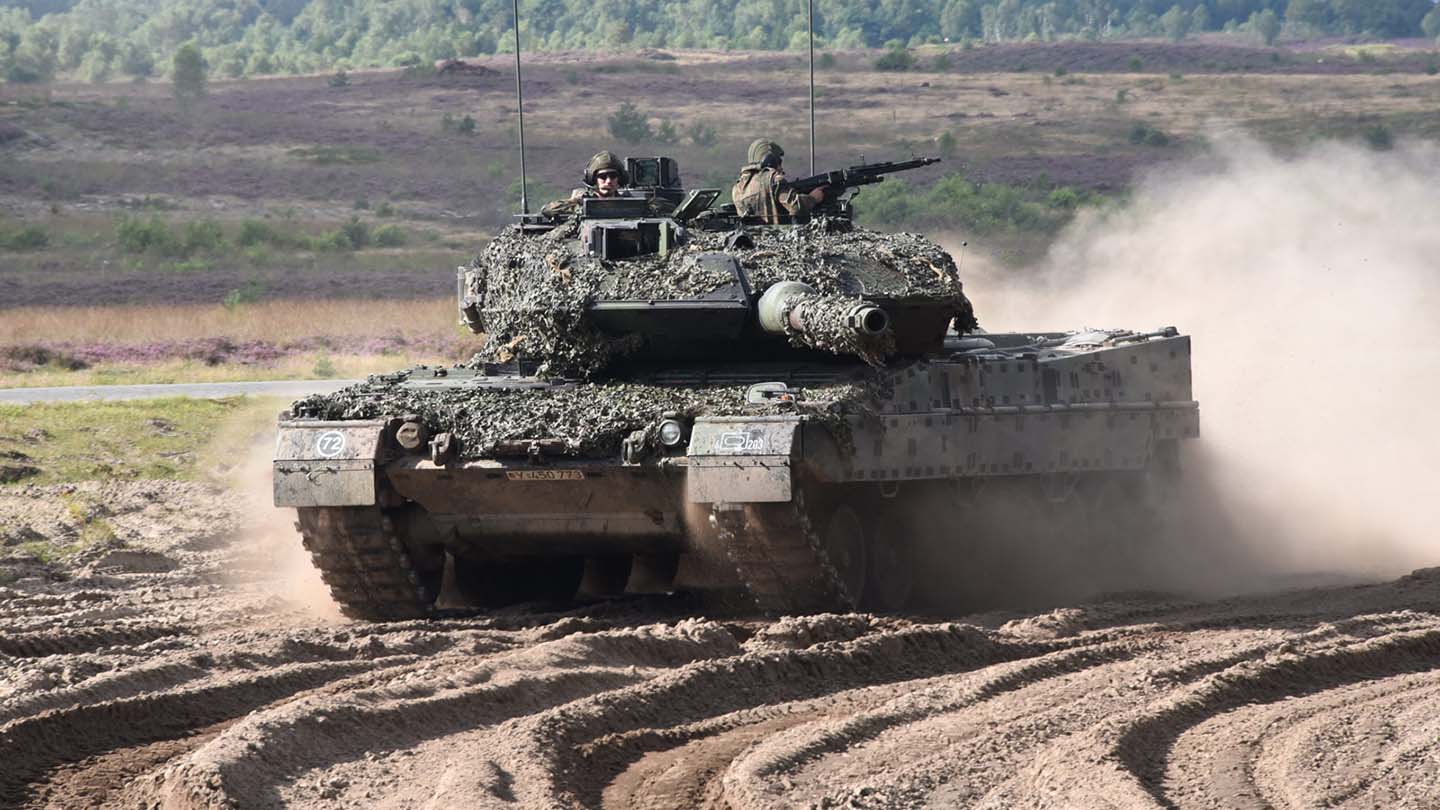As Ukraine and Russia battle fiercely in places like Bakhmut and Kreminna, Kyiv’s allies are dealing with their own contentious issue – the ongoing to-be-or-not-to-be saga of sending modern tanks to Kyiv.
But this might all come to ahead tomorrow during the eighth meeting of the Ukraine Defense Contact Group, where some 50 nations are gathering to determine how best to arm Ukraine in its fight against Russia.
There was action on tanks even before that meeting. The U.K. has already announced it will send Ukraine Challenger 2 tanks. And on Thursday, a group of NATO nations, meeting in Estonia, issued what it called the “Tallinn Pledge,” calling for Ukraine to receive modern tanks, among many other weapons.
“We commit to collectively pursuing delivery of an unprecedented set of donations including main battle tanks, heavy artillery, air defense, ammunition, and infantry fighting vehicles to Ukraine’s defense,” according to the document signed by the defense ministers of Estonia, the United Kingdom, Poland, Latvia and Lithuania; and the representatives of Denmark, the Czech Republic, the Netherlands, and Slovakia. “This substantial assistance to Ukraine comes from our own national stocks, and resources illustrating the mutual understanding of the severity of the situation and our commitment to urgently increase and accelerate support for Ukraine.”
Poland said it “is ready to donate a company of Leopard 2 tanks with 1,000 pieces of ammunition. Pending this, a wider coalition of Leopard 2 tanks donors will be established.”
Slovakia said it would consider sending tanks as part of that effort.
Meanwhile, Latvia’s defense minister told Reuters that several countries will announce they are sending “hundreds” of Leopard 2 tanks to Ukraine
“Some of the countries will definitely send Leopard tanks to Ukraine, that is for sure”, Arvydas Anusauskas told Reuters, about the Ramstein pledges, speaking after a preparatory meeting of 11 nations in Estonia.
There is no shortage of those weapons in Europe. A dozen nations have more than 2,300 variants of the Leopard 2 tanks in NATO and European nation stocks, according to the International Institute for Strategic Studies. The Leopard is at the heart of this debate.
A holdup, as we reported yesterday, is that Germany, which holds the licenses to those tanks, has so far refused to allow them to be shipped to Ukraine until and unless the U.S. first sends M-1 Abrams tanks, something the Pentagon again on Thursday said it was still not ready to do. There were no tanks on the latest list of weapons the U.S. will send to Ukraine, released Thursday afternoon. And after Defense Secretary Lloyd Austin met with his new counterpart, German Defense Minister Boris Pistorius, there were effusive thanks for all that Germany has already provided or promised, like IRIS-T SLM air defense systems, a Patriot air defense battery and Marder Infantry Fighting Vehicles (IFVs). But tanks were not mentioned in the post-meeting joint availability.
But in an interview with the German ARD TV station, Pistorius left open the possibility that there need not be a link between the German and U.S. tanks, according to Reuters.
“I’m not aware of any such stipulation,” Pistorius told ARD television when asked if that meant Abrams and Leopards had to be delivered at the same time, a position that leaves open the possibility of an agreement on Friday.
Leopard 2 tanks aren’t the only ones being considered for Ukraine. A French official in Washington, D.C., told The War Zone Thursday night that Paris is examining the request for Leclerc main battle tanks at the National Assembly. Each possible transfer is examined by the French government along three criteria – as always when France considers these things – equipment is used for defensive purposes, the shipment does not weaken France’s defensive systems and the equipment can be maintained in operational condition.
Allies have already agreed to provide Ukraine with a mix of armor.
Just today, Sweden agreed to send Ukraine advanced CV90 series IFVs, the standout item in Sweden’s new package of military aid to Ukraine, announced by the government in Stockholm today. While a Swedish arms transfer had been expected, previously only the Archer self-propelled artillery system had actually been confirmed, with the CV90 now ensuring that Ukraine will also get its hands on one of the most capable IFVs currently available in Europe.
The CV90 joins a large number of other armor vehicles promised to Ukraine, including FV432 Mk 3 Bulldog tracked armored personnel carriers from the U.K., 109 M2A2-ODS Bradley Fighting Vehicles and 90 Stryker eight-wheeled armored vehicles from the U.S., the aforementioned Marders and AMX-10 RC “light tanks” from France. The Strykers and 59 of the Bradleys were included in a new aid package valued at $2.5 billion that the Pentagon announced just today, which you can read more about here.

The United Kingdom opened the doors to tanks last week when it announced it is sending Ukraine Challenger 2 main battle tanks. At the time, a Ukrainian defense and military expert in Kyiv told The War Zone that there was hope the Challengers would challenge the U.S. and its allies to do likewise.
With the latest tank news out of the Baltics, pressure is clearly mounting on both Washington and Berlin to make that happen.
Ukraine, bogged down in Donbas, aiming to liberate Crimea and concerned about a potential Russian offensive in the coming months, says it desperately needs those tanks.
“We welcome the bold and very timely decision of the United Kingdom to transfer the first squadron of Challenger 2 tanks to Ukraine,” Ukrainian Defense Minister Oleksii Reznikov and Foreign Minister Dmytro Kuleba said in a joint statement Thursday.
“However, it is not sufficient to achieve operational goals. Therefore, we are addressing our appeal to the states that have Leopard 2 tanks in service, including Canada, Denmark, Finland, Germany, Greece, the Netherlands, Norway, Poland, Portugal, Spain, Sweden, and Turkey. We guarantee that we will use these weapons responsibly and exclusively for the purposes of protecting the territorial integrity of Ukraine within internationally recognized borders.”
The two leaders appealed “to all these and other countries possessing appropriate capabilities to join the initiative on establishment of an international tank coalition in support of Ukraine and make their practical contributions to this cause.”
On the other side of the tank issue, Russia is considering sending its T-14 Armata tank, its newest and most advanced, into service in Ukraine, the U.K’s Defense Ministry (MoD) reported.
It is unclear whether they have actually done so, the U.K. noted.
“Any T-14 deployment is likely to be a high-risk decision for Russia,” the MoD said. “Eleven years into development, the program has been dogged with delays, reduction in planned fleet size and reports of manufacturing problems. An additional challenge for Russia is adjusting its logistics chain to handle T-14s because it is larger and heaver than other Russian tanks.”
Before The War Zone readers dive into the rest of the most recent updates on the ongoing conflict below, they can first get up to speed on recent developments through our previous rolling coverage here.
The Latest
It is just a small town with a few streets, but Klischiivka, in Donetsk Oblast, may play a huge role in the future of the besieged city of Bakhmut.
On Thursday, the Head of the Wagner mercenary organization claimed his forces captured Klischiivka, which is just five miles south of Bakhmut and bisected by a road named Mariupolskaia, named for the now-devastated Azov Sea port city of Mariupol.
“We can safely say that the settlement of Kleshcheevka, which is one of the important suburbs of Bakhmut, has been completely taken under the control of Wagner PMC units,” the head of the Wagner Group, Yevgeny Prigozhin, announced on his Telegram channel Thursday, using the Russian alliterative spelling of the town’s name. “Fierce fighting is still going on around Kleshcheevka. The enemy clings to every meter of the earth.”
“Contrary to various opinions that the Armed Forces of Ukraine are fleeing from [Bakhmut] … this is not so,” Prighozhin’s Telegram channel added.
The Armed Forces of Ukraine “work clearly and harmoniously. We have a lot to learn from them. But in any case, the units of PMC ‘Wagner’ are moving forward meter by meter. The settlement of [Bakhmut] will be taken.”
Ukraine’s Defense Ministry has not commented directly on these claims, but said in its most recent situation report that Klischiivka was one of a dozen in Donetsk “damaged by fire” from Russian forces, indicating that the town is at least contested.
“I would like to celebrate the successes of the border guards of the Luhansk and Kramatorsk detachments, who, together with other warriors of the defense and security forces, are fighting in the Donetsk direction, defending Bakhmut,” Ukrainian President Volodymyr Zelensky said in his evening address Thursday, without specifically mentioning Klischiivka. “Thank you, guys, for your resilience and ability to inflict such losses on the enemy that gradually make the occupiers’ attacks meaningless!”
During a Thursday afternoon press briefing, Sabrina Singh, a Pentagon spokesperson, could not offer specifics about the status of Klischiivka, but told The War Zone that neither Bakhmut, nor Soledar – about 12 miles northeast of that town – have fallen completely into Russian hands yet.

“We’re still continuing to see intense fighting on both sides from the Ukrainians and Russians in and around Bakhmut and Soledar,” she said. “It is blocks to kilometers every day that continue to change hands. But the Ukrainians are not giving up their fight and neither are the Russians. They’re really dug into the ground right now.”
The current weather, Singh said, is more favorable for maneuvering around the battlefield.
“It is winter so the roads or the ground is a bit more frozen over which allows for vehicles to move around a bit more with more maneuverability,” she said. “This is a grinding fight that we’re seeing in the east.”
By capturing Klischiivka, the Russians are able to further their efforts to encircle and ultimately capture Bakhmut, cutting off resupply and communications routes from the south and west and bringing additional fire control to the area, the pro-Russian analysts said Thursday.
“Kleshcheevka is a very important settlement in the south of Bakhmut, as there is access to transport routes along which ammunition and personnel are transported to the Bakhmut area,” said Vitaly Kiselev – a military expert and colonel from the so-called Luhansk People’s Republic separatist military organization – according to the pro-Russian NewsFront news agency. “And from there [from Kleshcheevka], it is already possible to block these roads with mortar batteries and artillery and defeat the enemy. For us, this is a very important strategic settlement, which today is completely under our control.”
The loss of Klischiivka “poses a huge threat to the garrison of the Armed Forces of Ukraine both Bakhmut and Chasov Yar” about eight miles to the west, the pro-Russian Rybar Telegram channel wrote Thursday. “Ukrainian formations are trying to counterattack with the support of cannon and self-propelled artillery (eight M777 howitzers and M109 self-propelled guns), located on the western outskirts of Krasnoe.”
Ukraine, however, still holds the high ground to Bakhmut’s west, which is easier to defend, The Wall Street Journal reported Thursday.
Ukrainian officers and soldiers in Bakhmut told the newspaper that the Russians have been moving into Bakhmut from several directions in recent days, moving building by building but taking huge losses. On Thursday, Ukrainian soldiers were strengthening defensive positions within the city, including pillboxes made of concrete blocks and large sandbags.
Those defensive positions will make Bakhmut a very tough target for Russian forces, even if they have captured Klischiivka and encircle the city.
Regardless of what happens in Bahkhmut, U.S. officials have downplayed what the fall of that city could mean to Ukraine, saying it would have little overall strategic impact on Ukraine’s efforts to liberate the country, including Crimea.
But with both sides losing huge amounts of troops and equipment in battles over meters in and around Bakhmut, it will likely prove a Pyrrhic victory for Russia and it remains to be seen how, if at all, it will blunt Kyiv’s ambitions to restore the pre-2014 boundaries. But even with territory gained and a propaganda win, when it is all over, Russia will have to ask, given all that it has sacrificed, whether a victory in Bakhmut, should it happen, was worth the cost.
Elsewhere on the battlefield, little has changed. Both sides continue to trade territory in the Luhansk Oblast, along the P-66 Highway running from Svatove to Kreminna, while the Russians appear to be bolstering their presence in Zaporizhzhia Oblast, which would be key in an effort by Ukraine to advance toward Crimea. Here are some key takeaways from the latest Institute for the Study of War assessment:
- Russian forces continued limited counterattacks to regain lost positions near Kreminna.
- Russian forces continued offensive operations near Soledar, Bakhmut, Avdiivka, and Donetsk City.
- Ukrainian officials have indicated that Russian forces are concentrating in Zaporizhia Oblast, possibly for a large defensive or offensive effort.
- Russian forces’ increasing use of incendiary munitions to conduct what appear to be otherwise routine strikes in southern Ukraine supports ISW’s recent assessment that Russian forces likely face a shortage of conventional artillery rounds.
- Ukrainian and Russian sources continued to indicate that Russian authorities are likely preparing for a second wave of mobilization.
Amid all the news about tanks and other weapons flowing to Ukraine – and The New York Times report yesterday that the U.S. is warming to the idea of giving Ukraine weapons to strike Crimea – the Russians are not happy.
“We will destroy any weapons supplied to Zelensky’s regime by either the United States or NATO,” said Anatoly Antonov, Moscow’s ambassador to the U.S.
With tough battles ongoing and others looming, Ukrainian troops are training in the U.K. for urban warfare.
Russia and its client state Belarus are still conducting their joint training exercise. As we reported yesterday, Ukraine has not moved additional troops to the border as a result.
Russian troops writ large may be having trouble with supplies, but at least their snipers are well equipped, as these pictures and video below indicate.
And finally, despite all the horror taking place at home and the pressures of trying to gather enough arms and ammunition to continue the fight, Ukraine continues to maintain a sense of humor.
That’s it for now. We will update this story if there is anything major to add.
Contact the author: howard@thewarzone.com
